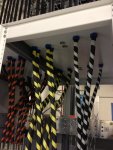arubenstein
Member
Hello,
I have googled and searched this forum quite a bit about my issue, and while I see some relevant references, I open the floor for more comment.
The application is the wiring of a 600 kw generator. As it stands now, the genset has a 800 amp breaker in an enclosure which is attached to the generator. We have wired to that breaker, using RHH/RHW type cable, two conductors per phase and a single neutral, for a total of seven cables. We exit the enclosure, having drilled one hole per conductor, and then bring the cables to a ventilated, uncovered cable tray. The conductors are arranged in the tray as AABBCCN. Each cable is 1" in diameter (262 mcm) and then has a 1" space between. The cable is cable tied to the cable tray at a frequency of about once per two feet.
At the 'other end' of the cable tray, we drop out of the cabletray into the top of a piece of switchgear, and again, having drilled one hole per cable, we come into that switchgear and then land on the bus bar within.
My questions are:
a) is the cable arrangement of AABBCCN in the single cable tray actually a problem? From what I have researched, I don't believe so. But I am happy to be corrected.
b) is the way that the enter the switchgear an issue (one cable per hole drilled in metal)? From what I have researched, this is the real issue. I believe the solution to be to rearrange the wires so that all seven conductors enter through the same hole.
I have attached a photo showing.

I am not trying to force a situation down an inspectors throat or slip one by; I want to know the real issues and what the proper technique is.
I have googled and searched this forum quite a bit about my issue, and while I see some relevant references, I open the floor for more comment.
The application is the wiring of a 600 kw generator. As it stands now, the genset has a 800 amp breaker in an enclosure which is attached to the generator. We have wired to that breaker, using RHH/RHW type cable, two conductors per phase and a single neutral, for a total of seven cables. We exit the enclosure, having drilled one hole per conductor, and then bring the cables to a ventilated, uncovered cable tray. The conductors are arranged in the tray as AABBCCN. Each cable is 1" in diameter (262 mcm) and then has a 1" space between. The cable is cable tied to the cable tray at a frequency of about once per two feet.
At the 'other end' of the cable tray, we drop out of the cabletray into the top of a piece of switchgear, and again, having drilled one hole per cable, we come into that switchgear and then land on the bus bar within.
My questions are:
a) is the cable arrangement of AABBCCN in the single cable tray actually a problem? From what I have researched, I don't believe so. But I am happy to be corrected.
b) is the way that the enter the switchgear an issue (one cable per hole drilled in metal)? From what I have researched, this is the real issue. I believe the solution to be to rearrange the wires so that all seven conductors enter through the same hole.
I have attached a photo showing.

I am not trying to force a situation down an inspectors throat or slip one by; I want to know the real issues and what the proper technique is.
